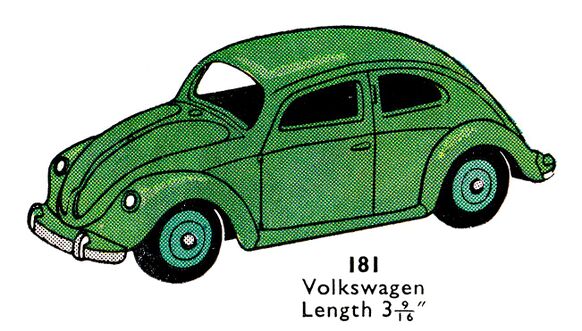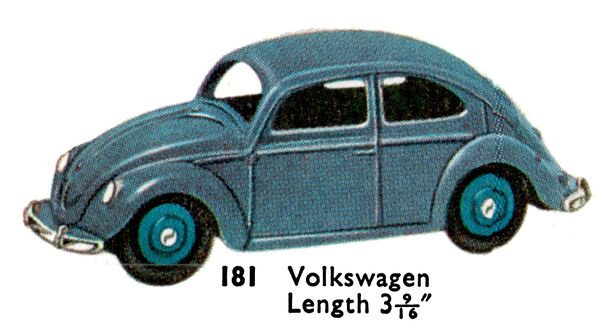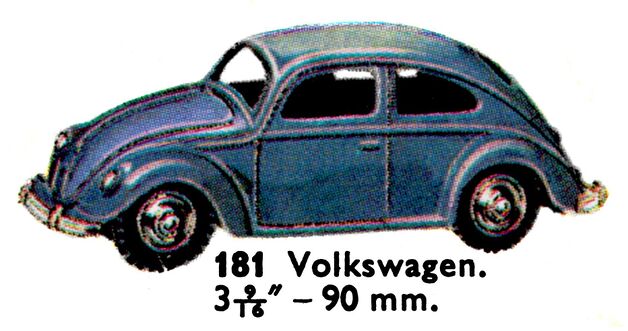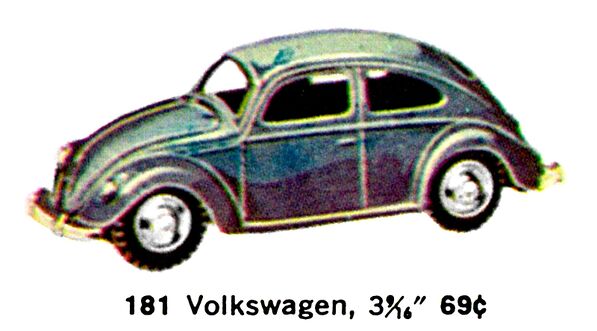Volkswagen "Beetle" (Dinky Toys 181)
| Exhibit |
|---|
Volkswagen "Beetle" (Dinky Toys 181) Dinky Toys 181 Volkswagen Saloon (i) Dinky Toys 181 Volkswagen Saloon (i)
|
 |
| location: |
|
Arch Two , Area 21 Classic Dinky Toys (John Durrant Collection) |
| Shelf 6
1956 - 1970 |
A white Volkswagen "Beetle" Saloon, Dinky Toys 181, with blue wheels and black tyres, a white top and a silver radiator grille.
The Dinky Toys "Beetle" was launched in Meccano magazine in February 1956, and produced until 1970.
Catalogue illustrations:
The Volkswagen "Type 1"
The idea of a "Volkswagen", or "People's Car" was one of a number of German "people's" products that Adolf Hitler decreed in the 1930s ought to be designed and put into production, with the design of the new Volkswagen being entrusted to Porsche.
The Volkswagen economy car had some design similarities with the WW2 Jeep and the later 1948 Citroen 2CV in that it was meant to be reliable, cheap and easy to repair. However, where the Jeep was optimised for ruggedness and general purpose military customisation, and the 2CV was optimised for small French farmers (with high wheel clearance and easy customisability for carrying goods to market), the Volkswagen was designed for urban use, with an aircooled engine for the benefit of owners who didn't have garages.
Where the 2CV was notable for having flat sides, and the Jeep had flat everythings, Porsche seem to have decided to show off their bodyworking skills by making sure that the Volkswagen bodyshell was as free from straight lines as possible - it was a shape that clearly had to have been created by an experienced bodywork designer rather than just bolted together with some pleasant aesthetics, like the later Jeep. Work on the various early versions of the car took quite a long time, and there was only a small window between the car's launch in 1938 and World War 2. The car was not a wild success, and much of the production then went to the military, although the car wasn't much use for anything other than driving small groups of people along good roads. The car's chassis and internals were, however used (sans bodyshell) as the basis of the amphibious WW2 Schwimmwagen.
Postwar
The postwar success of the Volkswagen Beetle is usually attributed to Major Ivan Hirst of the British Army. Having taken possession of the factory from the Americans, and after the car's design and tools had been offered to British car manufacturers and flatly turned down on the basis that the car was too "odd" to be saleable, Hirst seems to have decided that since it was a good idea to try to rebuild something of German industry, and since he and his men were now in control of a "Beetle" plant that nobody wanted, that he was going to make it his personal mission to make the factory and the car a success, regardless of what the automotive industry experts said.
Under Hirst's military direction, the factory was fixed up and production of the old Beetle restarted, and the British armed forces had their arm twisted to persuade them to buy enough of the initial production to kickstart the project. As postwar austerity gradually faded and production increased, the Beetle's oddness started to work in its favour. Cut off from its original 1930s context of being a workhorse people-moving tool for the masses, the Beetle bodyshell design now clearly failed its original design brief of being an inspirational piece of futuristic mass-market streamlined design ... but since it looked so different from the increasingly tired and traditional redesigns-of-redesigns being churned out by the major car companies, the Beetle now looked like a car that had deliberately been designed to look individualistic, and quirky, and perhaps even ... fun!






